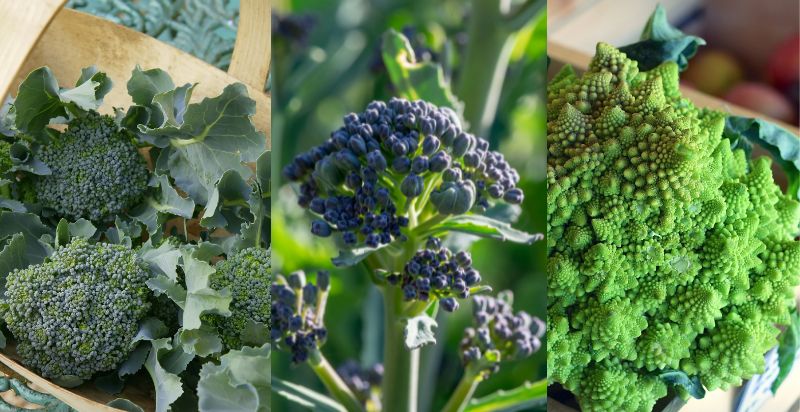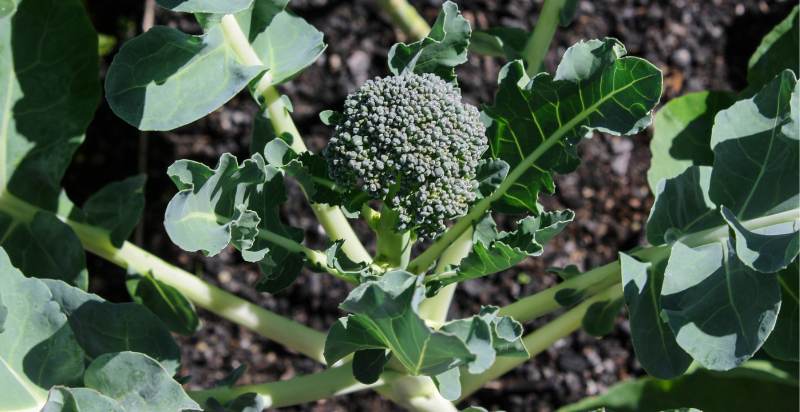Broccoli is a well-known green vegetable that is part of the cabbage family. It has become increasingly popular over the past few decades due to its health benefits, versatility, and taste. This blog post will look at what broccoli is, how it’s grown, its nutritional value, its health benefits, how to cook it properly, and how to include it in your diet.
What is Broccoli?
Broccoli is an edible green plant that belongs to the same family as cabbage plant and cauliflower plant . It’s typically characterized by its long, green stems and small florets (the flowering part of the vegetable). The flavor ranges from slightly sweet and earthy to bitter and pungent. Several varieties of broccoli are available, including purple sprouting broccoli, calabrese broccoli, gai lan (Chinese broccoli), and broccolini.
History and Origin of Broccoli:
Broccoli originated in the eastern Mediterranean region and dates to ancient Roman times. It was later introduced to other parts of Europe and eventually made its way to North America during colonial times. Today, broccoli is widely grown worldwide and is one of the most popular vegetables in many countries.
Types of Broccoli:
Several types of broccoli are available, including purple sprouting broccoli, calabrese broccoli, gai lan (Chinese broccoli), and broccolini. Depending on the variety, some have a sweeter flavor, while others can be bitter and pungent.

Description of Broccoli:
Broccoli is typically characterized by its long, green stems and small florets. The stems are edible and can be cooked in a variety of ways. Depending on the type, the florets can range from dark green to deep purple. Broccoli also has a unique flavor that some describe as sweet and earthy, while others find it slightly bitter and pungent.
Cultivation of Broccoli:
Broccoli is typically grown in temperate climates and prefers cooler temperatures. Depending on the variety and climate, it takes about 90–120 days from planting to harvesting. Broccoli can be grown in a home garden with access to sunlight and water.
How Is Broccoli Grown?
Broccoli is a cool-season crop that grows best during the spring or fall months. It usually started from seed indoors before being planted outside. It’s typically grown in loose, well-drained soil enriched with compost or fertilizer and kept moist. To ensure high yields, the soil should be kept weed-free, and the plants should be given regular care throughout the growing season.
Nutritional Value of Broccoli:
Broccoli is an excellent source of vitamins A, C, and K and dietary fiber. It contains several minerals, including manganese, phosphorus, potassium, and magnesium. Additionally, broccoli is low in calories yet rich in nutrients. One cup (91 grams) provides 31 calories, 6 grams of carbs, 3 grams of protein, and 2 grams of fiber.
Health Benefits of Broccoli:
Eating broccoli regularly may offer several health benefits. It’s high in antioxidants, which may reduce inflammation and protect against chronic diseases. It also contains anti-cancer compounds like glucosinolates and sulforaphane, which have been shown to help prevent cancer growth. Additionally, the dietary fiber in broccoli may aid digestion and improve gut health.
Overall, broccoli is an incredibly nutritious vegetable that has many health benefits. It’s low in calories yet rich in vitamins and minerals, making it an excellent choice for those looking to improve their overall nutrition. Its versatility makes it easy to include in various dishes and meals. So if you are looking to grow broccoli, here is everything you need to know :
How to Plant Broccoli?
Planting broccoli is a simple and rewarding process that can be done in any garden. The best time to plant broccoli is in the early spring when temperatures are cool but not freezing.
To plant your broccoli, start by finding a spot in your garden with well-drained soil that gets plenty of sunlight during the day. If you’re planting multiple plants, space them at least 18 inches apart.
When it’s time to plant your broccoli, dig a hole about twice as deep and wide as the roots of the plant, place the plant in the hole and cover it with soil, pressing lightly around its base to secure it in the ground, water the plant deeply to help the soil settle and provide moisture for growth.
Once your broccoli is planted, give it plenty of water, about 1-2 inches per week. Mulch around it to keep weeds away and hold in moisture. Provide ample fertilizer throughout the growing season as needed, but avoid high nitrogen fertilizer, as broccoli is a slow-growing crop.
In the late summer and early fall, you should start to see heads of broccoli form on your plants. When they reach maturity (about 2-3 months after planting), harvest them carefully by cutting off the heads with scissors or a knife. Enjoy your fresh, homegrown broccoli!

How to Care for a Broccoli Plant?
Once your broccoli is planted, there are a few steps you need to take to ensure it grows healthy and strong. Water the plant deeply and regularly (1-2 inches per week) during the growing season. Fertilize as needed with a balanced fertilizer, but avoid high-nitrogen fertilizers. Mulch should be placed around the plant’s base to keep the soil moist and weed-free.
Watch your broccoli closely for signs of maturity in the late summer and early fall. When they’re ready to harvest, cut off the heads with scissors or a knife.
Finally, remove old or dead leaves from the plant as soon as possible to prevent disease and insects. With proper care, your broccoli plant should thrive and provide you with delicious homegrown produce for seasons to come.

Some additional tips about growing broccoli?
- Broccoli should be planted in a location with lots of sunlight and well-drained soil.
- Space multiple plants at least 18 inches apart.
- Water deeply and regularly (1-2 inches per week) during the growing season.
- Fertilize with a balanced fertilizer, but avoid high-nitrogen fertilizers.
- Mulch around the base of the plant to keep weeds away and hold in moisture.
- Watch for signs of maturity and harvest when ready (about 2-3 months after planting).
- Remove dead leaves from the plant as soon as possible to prevent disease and insects from taking over.
- Be patient, as broccoli is a slow-growing crop that takes some time to harvest.
With these tips in mind, you can be sure your broccoli will grow healthy and strong for future seasons.
Preventions from Pests and Diseases:
Using excellent cultural practices is one of the best methods to stop pests and illnesses from harming your broccoli. Start by choosing disease-resistant varieties that are adapted to your local climate. Keep your garden clean and free of debris, weeds, and old plant material, which can attract pests.
You should also practice crop rotation each year, meaning you should not plant broccoli in the same spot year after year. This will help prevent insects and diseases from building up in the soil and making your plants susceptible to attack.
Finally, use row covers or fine-mesh netting over your broccoli plants before the flowering stage to protect them from pests such as cabbage moths, aphids, and caterpillars. With these precautions, your broccoli should stay healthy throughout the growing season.

How to Harvest a Broccoli?
Harvesting broccoli is a relatively easy process. Start by watching the heads of your plants closely to see when they reach maturity, usually about 2-3 months after planting. If the florets are tight and green in color, it’s time for harvest!
Using scissors or a knife, carefully cut off the heads from the stems with one clean motion. Make sure to leave some smaller side shoots behind, as these will continue to produce small heads throughout the season.
Once you have harvested your broccoli, enjoy it fresh or store it in an airtight container in the refrigerator for up to five days. You can also blanch and freeze it for longer storage.

How to Store Homegrown Broccoli?
Freshly gathered broccoli must be properly stored if you intend to delay eating it. The heads can be stored in the refrigerator for up to five days by being wrapped in a damp paper towel and placed in an airtight container. Blanch the broccoli, then store it in the freezer for up to six months.
To blanch, boil a pot of water with 1-2 tablespoons of salt per gallon. Prepare an ice bath by filling a large bowl with equal parts of ice cubes and cold water. Cut your broccoli into small florets and submerge them in boiling water for 1-2 minutes. Immediately after, remove them from the boiling water and place them into the ice bath. Once cooled, drain and store the florets in an airtight bag or container in the freezer.
With proper storage techniques, you can enjoy your homegrown broccoli for months!
How to Cook Broccoli?
Broccoli can be cooked using various methods, including steaming, boiling, baking, roasting, or stir-frying. When cooking fresh broccoli, it should be washed thoroughly before being cut into smaller pieces. For optimal flavor and nutrition, cook it quickly over medium-high heat for a few minutes until tender but slightly crunchy.
Including Broccoli in Your Diet :
Broccoli can be a delicious and nutritious addition to your diet. It can be included in meals as a side dish or combined with other vegetables, meats, and grains for something more substantial. Additionally, it’s versatile enough to be used in soups, stews, salads, and casseroles. You can even enjoy it raw as part of a veggie platter or dip.

Potential Risk from Broccoli:
Though broccoli is rich in vitamins and minerals, it does contain some components that may cause harm if consumed excessively. One of these components is oxalates, linked to kidney stones. Eating moderate amounts of broccoli as part of a balanced diet should not present any risk to your health. However, individuals prone to developing kidney stones or those taking certain medications should consult a doctor before consuming large amounts of broccoli.
Broccoli also contains high levels of vitamin K, which can interfere with blood-thinning medications such as Warfarin. It is important for individuals on these types of medications to monitor their consumption and speak with a doctor about the potential risks associated with eating large quantities of broccoli.
Conclusion:
In moderation, as part of a healthy diet, broccoli is a delicious and nutrient-dense vegetable. With the right cultural practices, harvesting strategies, and storage practices, you can continue to enjoy homegrown broccoli for months to come. But it’s crucial to be aware of the dangers of consuming much of this veggie. Always consult your doctor if you have any queries or worries about taking broccoli.
- Everything You Wanted to Know About Red Tamarillos - June 2, 2025
- A Guide to Tulips: Everything You Need to Know & More… - June 2, 2025
- Guanabana: Description, Flavor, Benefits, And Uses - May 27, 2025

22 thoughts on “Broccoli Plants: How to Plant, Grow, and Harvest Broccoli”
Comments are closed.